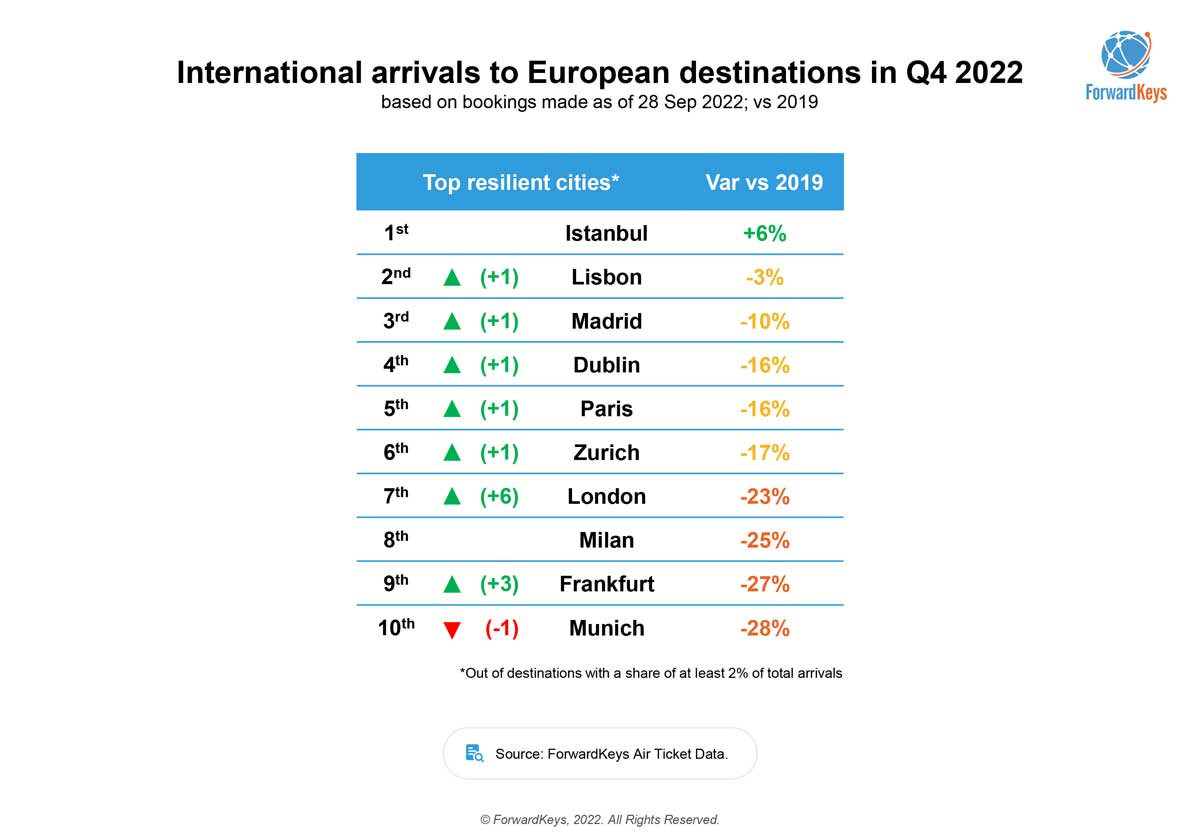
The travel sector in Europe is slowly but surely showing signs of recovery in the post-pandemic with Istanbul, Lisbon, and Madrid showing strong results.
NB: This is an article from ForwardKeys
And the best news? Travel recovery across Europe is set to continue in Q4 despite all the doom and gloom in the news about inflation, recession, oil prices and the war in Ukraine.
Subscribe to our weekly newsletter and stay up to date
Southern destinations will continue to lead but recovery accelerates in Northern Europe
The air ticketing data shows a marked improvement in the second half of the year. In Q3 international arrivals to Europe were down by 29% compared to 2019 levels, an improving figure but still behind in bookings compared to Africa and the Middle East, -19% and the Americas, -24%.
Overall, the arrival figures in Q4 across all of Europe will see an improvement in Q3 and the figures show a recovery in Q4 2022 versus Q4 2019 figures.

The comeback of urban destinations
After months of sun and beach domination, finally, urban destinations are attracting more international visitors. ForwardKeys data shows a progressive recovery in urban tourism vs 2019 levels as we get closer to the end of the year, while sun and beach destinations show plateauing figures except for October when key source markets like Germany and the UK enjoy the autumn half-term school holidays in beach resorts of Southern Europe such as the Canary Islands, in the last chance of catching some sun before the next year.

Istanbul, Lisbon, and Madrid are set to continue attracting international arrivals close to pre-pandemic levels past the classic summer months. Istanbul even shows growth figures in both Q3 and Q4. Istanbul´s strong performance is linked to the resilience of both long-hauls as well as intra-European markets. “Boosted by a weak Lira and excellent connectivity, Istanbul was again the best performing city in Q3 2022 and is set to remain in the green during Q4, as bookings currently are 6% above 2019 levels,” says Olivier Ponti, VP of Insights at ForwardKeys.

The current fall of the Euro and the rise of the dollar will see more US travellers in Europe in the last quarter of the year.
“As of 11 October, we see that recovery for travel from the US to Europe in Q3 stood at -6% vs 2019, with destinations such as Lisbon +47%, Athens +27% and Milan +12% all showing growth on pre-pandemic levels. For Q4 we see further improvement for Lisbon as a destination for US passengers, currently, at +50% over 2019 levels, this is being driven by arrivals from San Francisco at +119%, and Washington and Miami both at +84%,” reveals Ponti.
“The US market is returning in strength as the result of a strategy of developing several new routes from US cities to Lisbon. The pandemic period interrupted it for two years, but now the effort continues and seems to be already paying off,” said Vítor Costa, CEO of Turismo de Lisboa.
Lisbon will not only attract a fair share of US arrivals to its shores but also premium-class travellers from Latin America. Read more about this emerging trend as posted recently in this blog.
Threats & Opportunities in European City Tourism
With the ongoing conflict in Ukraine, rising airfares and cost of living one can expect a few more bumps on the travel road to recovery. Will airports be able to handle the Christmas rush? The good news is that the data at ForwardKeys shows a continuance of travel throughout Europe in Q4. “The booking situation shows there will be a strong demand but this may place airports and airlines under pressure again as we saw take place this summer,” says Ponti.

Besides the strength of transatlantic travel and the resilience of intra-European travel, the reopening of key Asian markets is also a cause for cautious optimism regarding the recovery of international travel to Europe.
“The recent lifting of travel restrictions in Hong Kong and Japan has made it easier for the nationals from these countries to return from an international trip, and Europe as a consequence is set to benefit from this,” adds Ponti.




